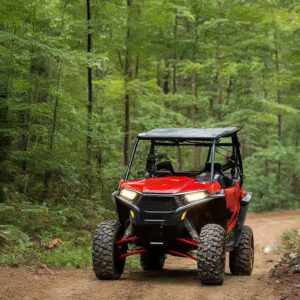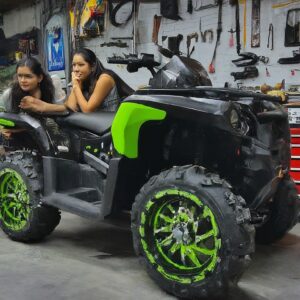ATVs (all-terrain vehicles) and UTVs (utility task vehicles) are similar off-road vehicles, but they have some key differences in their design, capabilities, and intended use. In this article, we see ATV vs UTV difference means we compare it and see which one is best.
ATV vs UTV difference
Now we are doing the comparison between UTV vs ATV.
1. ATV (All-Terrain Vehicle):

-
- Definition: An ATV, also known as a four-wheeler or quad bike, is a small off-road vehicle.
- Wheel Count: ATVs have at least three wheels.
- Seating and Controls:
- ATVs are controlled via handlebars.
- They typically have a straddle seat that accommodates only one rider.
- Most ATVs lack built-in rollover protection.
- Appearance:
- An ATV resembles a dirt bike with four wheels.
- It’s agile and designed for off-road adventures.
- Uses:
- ATVs are employed in agriculture, forestry, and search and rescue operations.
- They’re also popular for recreational trail riding and racing.
Know more about it What is an ATV
2. UTV (Utility Task Vehicle):

-
- Definition: A UTV, also called a side-by-side or recreational off-road vehicle (ROV), is designed to accommodate both a driver and a passenger sitting side-by-side.
- Wheel Count: UTVs have four wheels.
- Seating and Controls:
- UTVs are controlled via a steering wheel, not handlebars.
- They feature bench or bucket seats.
- Most UTVs come with built-in rollover protection in the form of a cage on top.
- Appearance:
- Many UTVs resemble rugged, off-road golf carts.
- They prioritize stability and hauling capacity.
- Uses:
- UTVs are commonly used for tasks requiring stability and cargo capacity.
- Professionals in farming, landscaping, and other industries rely on UTVs.
Safety Considerations of ATV vs UTV

ATV Safety Issues:
- Tipping Risks: ATVs may tip over, especially during sharp turns.
- Lack of Seatbelts: Traditional ATVs often lack seatbelts, posing a safety concern.
UTV Safety Advantages:
- Stability: UTVs, with a broader stance, exhibit enhanced stability.
- Rollover Protection: Many UTVs include rollover protection structures.
- Seatbelts: UTVs commonly feature seatbelts, enhancing passenger safety.
Also read What happens if You Get Caught Riding an ATV on the Road?
Pros and Cons of ATV vs UTV
Let’s explore the pros and cons of both ATVs (All-Terrain Vehicles) and UTVs (Utility Task Vehicles) to help you make an informed choice:
1. ATVs (All-Terrain Vehicles):
- Pros:
-
-
-
- Pricing: ATVs are generally more affordable than UTVs.
- Size: Smaller size allows for tight manoeuvring and quick turns.
- Racing: ATVs are great for off-road racing due to their agility.
- Lifestyle: Ideal for recreational trail riding and individual adventures.
- Footprint: ATVs have a smaller environmental footprint.
-
-
- Cons:
-
-
- Weight: Riding an ATV can be physically demanding due to its weight.
- Hauling: Limited cargo capacity compared to UTVs.
- Safety: Lack of a roof exposes riders to the elements.
- Accessories: Fewer options for adding accessories.
-
See: best ATV accessories
2. UTVs (Utility Task Vehicles):
- Pros:
-
-
-
- Safety: UTVs offer better safety with roll cages and seating for passengers.
- Hauling: Larger cargo bed for hauling equipment or supplies.
- Suspension: Enhanced suspension systems handle bumps and obstacles well.
- Comfort: More comfortable for longer rides.
- Accessories: UTVs come with various features and customization options.
-
-
- Cons:
-
-
- Pricing: UTVs tend to be more expensive than ATVs.
- Size: Larger size can be challenging in tight spaces.
- Steering: Steering with a wheel may feel less intuitive.
- Towing Capacity: UTVs have lower towing capacity than some ATVs.
- Environmental Impact: UTVs have a larger environmental footprint.
-
Conclusion
In summary, choosing between an ATV vs UTV depends on specific needs and preferences. ATVs excel in solo adventures, while UTVs prioritize versatility, accommodating passengers and cargo. Consider factors like intended use, handling preferences, and safety features when making your decision. Test-driving both vehicles is recommended to gauge their suitability for your individual requirements.
FAQs About ATV vs UTV Difference
Here are some FAQs about the UTV vs ATV.
Are ATVs safer than UTVs?
Safety depends on how you use them, where you ride, and if you follow safety rules. Both ATVs and UTVs can be safe if you use them carefully.
Can I use a UTV for fun?
Yes! Many UTV models are made for having fun, giving families and groups a comfortable and enjoyable time off the road.
Do I need special training to drive a UTV?
You don’t have to, but it’s smart to take a basic off-road vehicle safety course. This helps you understand how the vehicle works and how to use it safely.
Can I change my ATV to carry more stuff?
You can make some changes, but ATVs have limits on how much they can carry. If you need to haul a lot of stuff, a UTV might be a better choice.
How long do ATVs and UTVs last on average?
How long they last depends on how well you take care of them, how much you use them, and where you ride. With good care, both ATVs and UTVs can work well for many years.








